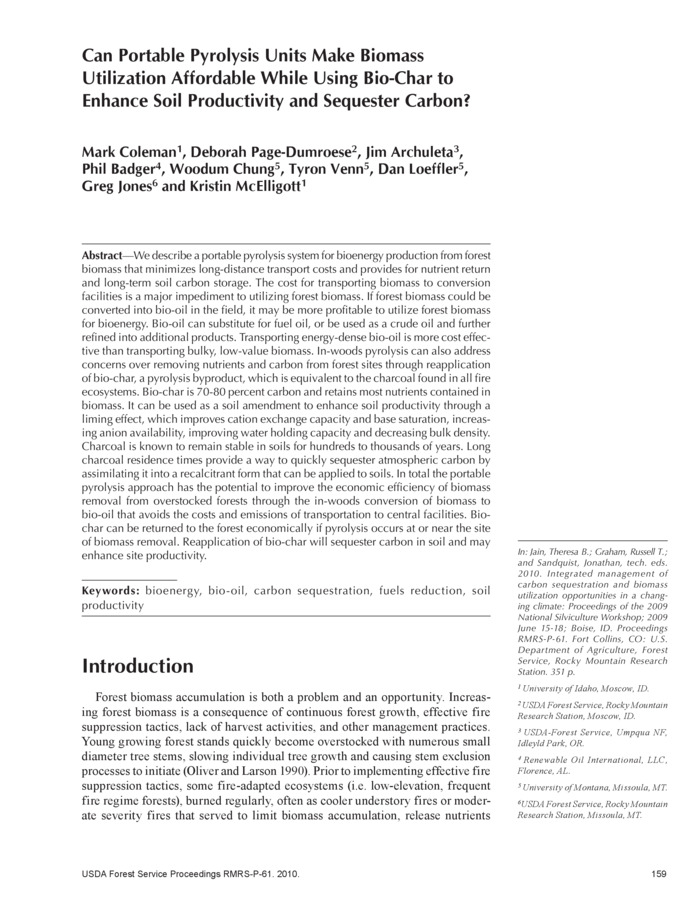PDF
Can Portable Pyrolysis Units Make Biomass Utilization Affordable While Using Bio-Char to Enhance Soil Productivity and Sequester Carbon? Item Info
- Title:
- Can Portable Pyrolysis Units Make Biomass Utilization Affordable While Using Bio-Char to Enhance Soil Productivity and Sequester Carbon?
- Creator:
- Coleman, M.; Page-Dumroese, D.; Archuleta, J.; Badger, P.; Chung, W.; Venn, T.; Loeffler, D.; Jones, G.; McElligott, K.
- Date Created (ISO Standard):
- 2010
- Description:
- We describe a portable pyrolysis system for bioenergy production from forest biomass that minimizes long-distance transport costs and provides for nutrient return and long-term soil carbon storage. The cost for transporting biomass to conversion facilities is a major impediment to utilizing forest biomass. If forest biomass could be converted into bio-oil in the field, it may be more profitable to utilize forest biomass for bioenergy. Bio-oil can substitute for fuel oil, or be used as a crude oil and further refined into additional products. Transporting energy-dense bio-oil is more cost effective than transporting bulky, low-value biomass. In-woods pyrolysis can also address concerns over removing nutrients and carbon from forest sites through reapplication of bio-char, a pyrolysis byproduct, which is equivalent to the charcoal found in all fire ecosystems. Bio-char is 70-80 percent carbon and retains most nutrients contained in biomass. It can be used as a soil amendment to enhance soil productivity through a liming effect, which improves cation exchange capacity and base saturation, increasing anion availability, improving water holding capacity and decreasing bulk density. Charcoal is known to remain stable in soils for hundreds to thousands of years. Long charcoal residence times provide a way to quickly sequester atmospheric carbon by assimilating it into a recalcitrant form that can be applied to soils. In total the portable pyrolysis approach has the potential to improve the economic efficiency of biomass removal from overstocked forests through the in-woods conversion of biomass to bio-oil that avoids the costs and emissions of transportation to central facilities. Biochar can be returned to the forest economically if pyrolysis occurs at or near the site of biomass removal. Reapplication of bio-char will sequester carbon in soil and may enhance site productivity.
- Subjects:
- research (document genres) pyrolysis
- Location:
- North and Central Idaho; Eastern Washington; Western Montana; Northeastern Oregon
- Publisher:
- USDA Forest Service Proceedings
- Source:
- Can Portable Pyrolysis Units Make Biomass Utilization Affordable While Using Bio-Char to Enhance Soil Productivity and Sequester Carbon? UDSA Forest Service Proceedings RMRS-P-61. 2010
- Source Identifier:
- Can_Port_Pyrolysis_Un_Make_Biomass_Utilization_Affordable_Using_BioChar_Enhance_Soil_Prod_Sequester_C_USDAFS_2010
- Type:
- Text
- Format:
- application/pdf
Source
- Preferred Citation:
- "Can Portable Pyrolysis Units Make Biomass Utilization Affordable While Using Bio-Char to Enhance Soil Productivity and Sequester Carbon?", Idaho Forestry Research Collection, University of Idaho Library Digital Collections, https://www.lib.uidaho.edu/digital/forestryresearch/items/forestryresearch948.html
Rights
- Rights:
- Educational use includes non-commercial use of text and images in materials for teaching and research purposes. Digital reproduction rights granted by University of Idaho Library. For other uses beyond educational use, please contact University of Idaho Library Special Collections and Archives Department at libspec@uidaho.edu.
- Standardized Rights:
- http://rightsstatements.org/vocab/InC-EDU/1.0/

